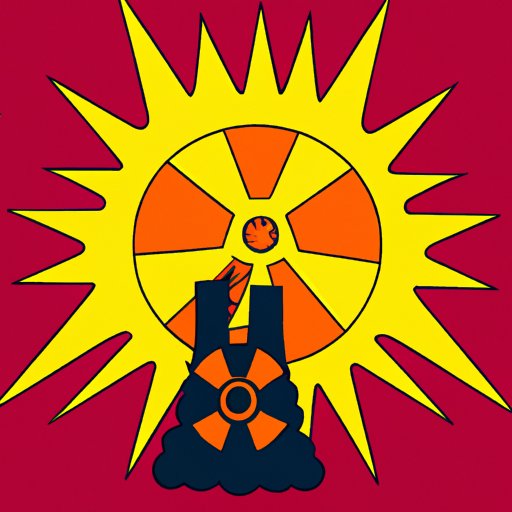Introduction
An atomic bomb is a weapon that uses the energy released by a nuclear reaction to create an explosion. Atomic bombs are the most powerful weapons ever created by humankind and can cause massive destruction. This article will explore the physics behind atomic bombs, examine the components required to build them, compare different types of atomic bombs, describe how the fission process works, analyze the effects of a nuclear detonation, and investigate the history of nuclear weapons development.

Explaining the Physics of an Atomic Bomb
The physics behind atomic bombs involves two types of nuclear reactions: fission and fusion. During nuclear fission, atoms are split apart, releasing tremendous amounts of energy in the process. During nuclear fusion, atoms join together to form heavier atoms, also releasing tremendous amounts of energy. Both of these processes occur within the core of an atomic bomb, creating an intense burst of energy.
Atomic bombs use a chain reaction to control the release of energy. When the atom splits, it releases neutrons, which then collide with other atoms, causing them to split as well. This process continues until the desired amount of energy has been released. The amount of energy released is determined by the size of the bomb’s core, referred to as its “critical mass.”

Examining the Components of an Atomic Bomb
In order to construct an atomic bomb, there are several components that must be present. The first component is the nuclear fuel, which is typically either uranium or plutonium. This fuel is surrounded by an explosive trigger, which sets off the chain reaction when it is detonated. The trigger is connected to a detonator, which causes the fuel to split apart. Finally, the bomb is encased in a tamper, which helps to contain the energy released during the reaction.

Comparing Different Types of Atomic Bombs
There are several different types of atomic bombs that have been developed throughout history. The first atomic bomb was known as “Little Boy,” and was used by the United States in 1945 against Japan. This bomb had a relatively small yield, but was still devastatingly effective. The second type of atomic bomb was known as “Fat Man,” and was also used by the United States against Japan in 1945. This bomb had a much larger yield than Little Boy, and was considered more destructive.
More recently, hydrogen bombs have been developed. These bombs use a combination of nuclear fission and fusion to create a much more powerful explosion than traditional atomic bombs. Hydrogen bombs are significantly more destructive than their predecessors, and are the most powerful weapons ever created by humankind.
Describing How the Fission Process Works
When an atomic bomb is detonated, the nuclear fuel inside the core is subjected to intense heat and pressure. This causes the fuel to split apart, releasing neutrons in the process. These neutrons then collide with other atoms, causing them to split apart as well. This chain reaction continues until the desired amount of energy is released. The amount of energy released is referred to as the bomb’s “yield,” and is determined by the size of the core.
When the fuel splits apart, it releases a tremendous amount of energy. This energy is released in the form of heat, light, and radiation, all of which can be incredibly destructive. The energy released is so intense that it can vaporize anything within a certain radius of the blast site.
Analyzing the Effects of an Atomic Bomb
When an atomic bomb is detonated, it produces three main effects: a blast wave, heat radiation, and an electromagnetic pulse. The blast wave is a shockwave that travels outward from the detonation site at supersonic speeds. This wave is powerful enough to destroy buildings and other structures in its path. Heat radiation is intense thermal energy released by the bomb, which can cause severe burns and other damage. Finally, an electromagnetic pulse is released, which can disrupt electrical systems and communications over a wide area.
The effects of an atomic bomb can be devastating. In addition to the physical destruction caused by the blast wave and heat radiation, the radiation released by the bomb can cause long-term health problems such as cancer and genetic mutations. The psychological impact of a nuclear detonation can also be profound, leading to feelings of fear, anxiety, and despair.
Investigating the History of Nuclear Weapons Development
The development of nuclear weapons began during World War II with the Manhattan Project. This top-secret project was led by the United States and involved scientists from around the world. The goal of the project was to develop an atomic bomb before the Nazis did. After years of work, the first atomic bomb was successfully tested in 1945, ushering in a new era of warfare.
Following the end of World War II, the United States and the Soviet Union engaged in a Cold War arms race to develop more powerful nuclear weapons. This race eventually led to the development of hydrogen bombs, which were even more powerful than atomic bombs. As the Cold War ended, the threat of nuclear war decreased, but the proliferation of nuclear weapons continues to be a major global concern.
Conclusion
Atomic bombs are the most powerful weapons ever created by humankind. They use a combination of nuclear fission and fusion to create an intense burst of energy, which can cause massive destruction. This article has explored the physics behind atomic bombs, examined the components required to build them, compared different types of atomic bombs, described how the fission process works, analyzed the effects of a nuclear detonation, and investigated the history of nuclear weapons development. While atomic bombs are incredibly powerful, they should never be used lightly, as the consequences of a nuclear detonation can be devastating.
(Note: Is this article not meeting your expectations? Do you have knowledge or insights to share? Unlock new opportunities and expand your reach by joining our authors team. Click Registration to join us and share your expertise with our readers.)
